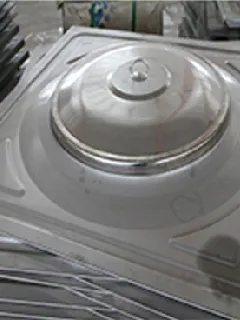loading...
- No. 9, Xingyuan South Street, Dongwaihuan Road, Zaoqiang County, Hengshui, Hebei, China
- admin@zjcomposites.com
- +86 15097380338
- Welcome to visit our website!
sectional tanks
Understanding Sectional Tanks A Comprehensive Guide
In the realm of modern water storage solutions, sectional tanks have emerged as a preferred choice for many industries and residential applications. Their flexibility, adaptability, and efficiency make them highly sought-after for diverse needs, ranging from municipal water supply to industrial processes. This article explores what sectional tanks are, their benefits, applications, and the factors to consider when selecting one for your needs.
What are Sectional Tanks?
Sectional tanks are modular water storage tanks constructed from various materials, including galvanized steel, stainless steel, and fiberglass. These tanks are designed in sections or panels that can be assembled on-site, making them easier to transport and install compared to traditional single-piece tanks. The sections are bolted or welded together to create a solid and durable structure capable of holding significant volumes of water.
Benefits of Sectional Tanks
1. Modularity One of the primary advantages of sectional tanks is their modular design. The sections can be added or removed according to storage needs, allowing for future expansion without significant structural changes.
2. Enhanced Transportability Because sectional tanks are composed of multiple panels, they can be easily transported to remote or challenging locations. This ease of transport makes them ideal for various applications, including temporary water storage for construction projects and agricultural uses.
3. Customization Sectional tanks can be tailored to meet specific requirements, such as capacity, shape, and material. This customization ensures that users can choose a solution that fits their precise needs.
4. Cost-Effectiveness The modular nature of sectional tanks often results in lower transportation costs and shorter installation times, which can lead to overall cost savings. Additionally, maintenance and repair can be easier due to the accessibility of individual sections.
5. Durability and Longevity Most sectional tanks are made from corrosion-resistant materials, providing long-lasting performance even in harsh environments. This durability is essential for maintaining water quality and ensuring that the tank can withstand weather changes.
Applications of Sectional Tanks
Sectional tanks are versatile and cater to a broad spectrum of applications, including
- Industrial Use They are widely used in industries for process water storage, firefighting systems, and wastewater management. Their large capacity and quick assembly make them ideal for extensive industrial operations.
sectional tanks

- Agricultural Storage Farmers utilize sectional tanks for storing water for irrigation, livestock, and other agricultural needs. Their ability to hold large volumes efficiently supports agricultural activities, especially in regions with limited water resources.
- Municipal Water Supply Local governments and municipalities frequently install sectional tanks as part of their water supply infrastructure. They are suitable for both temporary and permanent installations in urban and rural areas.
- Construction Sites Temporary water solutions are necessary on construction sites for various purposes. Sectional tanks are perfect for storing water for dust suppression, concrete mixing, or as emergency drinking water supplies.
Considerations When Selecting a Sectional Tank
When choosing a sectional tank, several factors should be taken into account
1. Material Selection The choice of material affects the tank’s durability, resistance to corrosion, and overall performance. Stainless steel tanks, for example, are excellent for food and potable water storage due to their sanitary properties.
2. Size and Capacity Determine the volume of water needed for your application and select a tank that meets those requirements. It’s essential to consider any future expansion needs.
3. Local Regulations Depending on your location, there may be specific regulations governing the installation and maintenance of water storage tanks. It’s crucial to consult local authorities to ensure compliance.
4. Installation and Maintenance Evaluate the logistical aspects of installation and ongoing maintenance. A well-assembled tank is essential for ensuring safety and efficiency.
5. Cost While sectional tanks can be cost-effective, it’s vital to compare prices and features from different manufacturers to find the best value for your investment.
Conclusion
Sectional tanks are a practical and efficient solution for various water storage needs. Their modular design, customization options, and ease of transport make them suitable for many applications across different sectors. By understanding the benefits and considerations associated with sectional tanks, consumers and businesses can make informed decisions that meet their water storage requirements effectively. Whether it's for industrial, agricultural, or municipal purposes, sectional tanks hold a significant role in ensuring accessible and reliable water storage solutions.
-
Transform Your Spaces with FRP Grating SolutionsNewsNov.04,2024
-
The Versatility and Strength of FRP RodsNewsNov.04,2024
-
The Excellence of Fiberglass Water TanksNewsNov.04,2024
-
The Benefits of FRP Grating for Your ProjectsNewsNov.04,2024
-
Elevate Your Efficiency with FRP Pressure VesselsNewsNov.04,2024
-
Welcome to the World of FRP Pressure VesselsNewsOct.12,2024
-
Unveiling the Future of Filtration: Why FRP Filter Vessels are a Game ChangerNewsOct.12,2024
